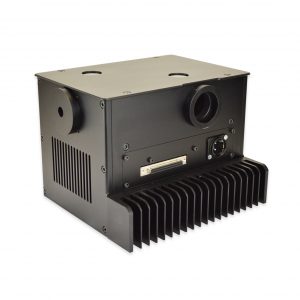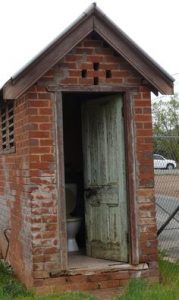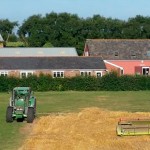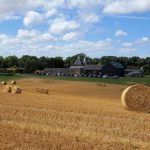The title for this blog was originally going to be “The First Thirty Years Were The Worst” until I realised that I’d already used that one in 2015! In case you doubt my sanity (although that’s a questionable issue in any case), I can explain that that anniversary was of the registration of Cairn as a Company, whereas this anniversary marks 30 years since I stopped being someone else’s employee, in Easter 1989, as until then Cairn had been a part-time operation.
In that blog I gave a fair amount of information about how Cairn started and why, but I was still a bit coy about some of the background. Now though, time has moved along a little more, so I reckon a “30 year rule” now applies, allowing me to reveal a little more about where the bodies are buried, without running too high a risk of prosecution! The truth is that Cairn was born out out of a period of personal professional adversity, but that has turned out to be the key reason for our own longevity and success, so I can’t tell the story properly unless I lift the lid on those crazy days.
Monochromator
But let’s start in the present, where things are so very different from then! We recently received an enquiry as to whether we could repair TILL monochromators, to which the answer of course was “No, but we’ll be happy to sell you a Cairn one!”. So why can’t TILL repair their monochromators? That’s because they basically don’t exist any more. They stopped making such things when they were taken over by FEI, who were then taken over by the ThermoFisher behemoth, and the concept of servicing those products somehow got lost along the way (we were approached because the customer was told they couldn’t help).
This is a far from unusual situation in our industry, and to which the second part of title refers. It’s a rework of a line in Bruce Springsteen’s “Born in the USA” song in which his (fortunately mythical) brother went off to fight the Viet Cong. “They’re still here but he’s all gone!” In the early days we were competing against such companies as Newcastle Photometrics (long since defunct), Glen Creston (soon subsumed by what has now become Jobin Yvon), Photon Technology International (now part of HORIBA), Improvision (acquired by Perkin Elmer) and Life Science Resources (we’re not sure what happened to them!). All gone indeed!
Changes of ownership
Other changes of ownership along the way to the present include Axon Instruments and Universal Imaging (both now part of Molecular Devices), Scientifica and CoolLED (both now owned by Judges Scientific), and Andor Technology, whose literature and personnel are both now badged as “An Oxford Instruments Company”. As a tribute to them in particular, I have a special “exhibitions” teeshirt, showing that Cairn is “A Cairn Research Company”. Well, it had to be done, and how and why we have managed to remain a Cairn Research Company, is going to be the major theme of this blog. But first, a few further observations to show just how unusual this situation is!
In our business area, only in the microscopy industry have there been any vestiges of stability, although Leica were bought by Danaher and Olympus got themselves into a dreadful financial mess a few years ago. Of our various suppliers, it’s nice to see that both Comar Optics and Chroma Technology are still as independent as ever, but our traditional Leeds-based electronics supplier Farnell, who used to be so “Yorkshire” that I used to imagine them all sharing an outside “privy” is now part of Phoenix-based Avnet. As another of many potential further examples, Cambridge Technology, who make the galvanometer drives we use in our Optoscan monochromator, now announce that they are a Novanta Company, whoever they are.
Independent
Have these Companies’ services improved as a result of the acquisitions? Of course not! For example, we were only aware of the Cambridge Technology acquisition because as one consequence they discontinued the particular galvanometer drives we use in our Optoscan monochromator. Fortunately we can re-engineer this product to use an alternative part, but it’s going to be an unnecessary effort with no discernible improvement in performance.
However, as tempting as it may be, this blog isn’t intended to be a rant against all this corporate nonsense. Instead, the question I want to address is why, after 30 years and counting, we have managed to avoid it – and that we reckon we can continue to do so! I think there are three possible answers. The first is that we may just have been lucky, which is of course possible, but our history has been so consistently drama-free that it doesn’t feel like it’s been a series of fortuitous outcomes from random processes. The second is that Cairn people are superbeings with special powers, but I don’t buy that one either. Yes, we are pretty darned good at what we do, but I reckon we’re at the top end of a continuum rather than being fundamentally different from the rest. For example, we’re not on main drainage at the farm, so the rate at which certain nitrogenous products need to be collected does confirm that at least the large majority of us have normal mammalian metabolisms here. So this just leaves the third answer, which is that it was planned that way!
Over-complicated pieces of equipment?
Cairn’s history effectively goes back to a very successful postdoc in the USA, where I was making realtime calcium concentration changes in nerve cells using absorbance dyes (Roger Tsien hadn’t invented the fluorescent ones yet), but somehow this didn’t impress the recruitment panels of the various British Universities to whom I was offering my services at the time. As I recounted in an article for Physiology News, the feeling seemed to be that I was spending far too much time building over-complicated pieces of equipment, and then just doing experiments that could have been done with anyone who had such equipment. Very unsound!
I’d taken that postdoc position in Boston because, after a safe but boring PhD, I felt like having a bit of an adventure somewhere, and it’s something from which I’ve never fully recovered. The very characteristics for which I was “marked down” by my homegrown elders and betters were lauded over there, which was more than a little disconcerting. But I was no great fan of American society, so I was keen to return to the UK, which in retrospect has been very ironic because since then the UK seems to have been aping the worst aspects of their society while missing out on much of the good stuff. The US has always been a bit of a rough-and-tumble sort of place, but also a great environment for those of us who want to do things!
Back in the UK
So there I was, back in the UK again, glad to be home but having to deal with the same old attitudes. My potential future university masters still weren’t so impressed with me, but I had reservations of my own. Yes it would be nice to have a tenured research position, but I would much rather be part of a continuing team, rather than having to sustain operations through a stream of students and postdocs, as most academics have to do. Therefore the possibility of securing a position at the (then) Shell Research Laboratories just outside Sittingbourne in Kent, looked to be a potential alternative way of achieving that goal. Since many other people had unsuccessfully interviewed for that position, it looked to be one that was very well worth having, so (in retrospect very naively!) I decided to give it a go when they offered it to me.
Back legs of the pantomime horse
Unfortunately, it steadily became clear that I was in the wrong place at the wrong time. Nobel prizewinning biological research (on the steroid biosynthesis pathway) had been carried out there not so many years before I joined so it had potentially sounded like a pretty cool place to be, but around the time I arrived a decision was made to require the research to be more directly relevant to existing business activities. Fine in principle perhaps, but following the Thalidomide scandal Shell were scared stiff about getting involved in pharmaceuticals, so that major potential market was a nonstarter for them, and (at least in my opinion) there weren’t sufficient alternative opportunities that could be made a go of on the scale in which Shell would be interested. I therefore progressively came to the view that they were doomed (yes they were), and things weren’t going at all well for me there personally in any case, so sooner or later I was going to have to do something else, and without much success to show for my time there!
Again in retrospect, and as I’d indicated in the Weirdos blog, what is now Cairn could so easily have been an American operation. Once it became clear that the starring role I’d thought Shell had offered me was actually the back legs of the pantomime horse, some plans were coalescing to return to the US on at least a part-time basis, both to continue the research but also to set up some sort of business with my old boss there, Tony Gorman. But fate intervened, as Tony suddenly died of a heart attack, leaving me wondering what to do instead. To help keep me (relatively?) sane meanwhile, I reactivated some old audio electronics interests from my student days, about which you can read more here which albeit indirectly gave me some useful experience of running a small business, although that blog should make clear why it wasn’t going to be a longterm business area for me!
Enduring operation
The business concept in general looked good though, but there was something else I didn’t have, and that has turned out to be one of Cairn’s major strengths. Many businesses are set up by several people together, but there were no natural partners around for me. An old Shell colleague (and still a friend) was happy to act as a second Director for the necessary legal purposes of setting up a proper Limited Company (by the way, he’s the person who came up with Cairn name, as we both wanted something generic rather than targeted towards some specific business area), but his longer term interests turned out to be elsewhere. Therefore our professional association soon ended, but without any blood spilt, whereas the business world is full of rancorous splits between the major shareholders. Here’s a current example. And even when everyone does get on well, sooner or later there is a chance that the founders will want to go their separate ways, and which may require the Company to be sold in order for them to realise their share of it. So, since I was very much having to do everything on my own, which of course wasn’t always easy, I also realised that this situation was potentially good news for the longer term. It was also just what I wanted, as I intended Cairn to be an enduring operation rather than just being a stepping stone to something else. I had indeed planned it that way!
Finance
Next of course is the issue of finance. Ultimately, any business tends to be controlled by whoever puts in the money, so for me that ruled out any form of outside investment – especially venture capital, where those people want to make a nice fat profit by taking a significant shareholding in your company and then taking their share of the proceeds when you go public, as this form of finance commits you to do. I’ll say a bit more about that at the end. And once you go public, you are exposed to anyone wanting to take you over, which I think was the story for Andor, for example. You may end up rich, if that’s what you want (or you may lose your house if things go badly), but it’s now somebody else’s Company. The banks have been no better, and in practice even worse, as there have been some real horror stories there.
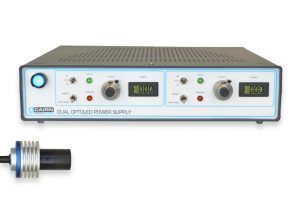
So, once I decided to go ahead with Cairn, I made the initially frustrating decision to stay at those Shell labs for a while longer, and to use that job as the source of our finances. The Titanic was still steaming full ahead towards oblivion, but that iceberg was still some way off! Having Cairn merely as a spare time operation in my house in those early days meant growth was slower, but the overheads were zilch. By 1988 I’d built up the business sufficiently to employ my local friend Adrian (who was otherwise laid up with a badly broken leg) full time, working in the spare bedroom, and this situation continued for a full year before I finally took the plunge myself, in Easter 1989. By then we’d made enough money to support us both for the best part of a year, but with me now properly on board, things really took off.
Another of my key strategic decisions, to make sure that Cairn was longterm sustainable, was to price our products according to what we should have charged for them if we had the overheads of a fully established business, rather than what they actually cost us to make. And especially so because much of the fluorescence photometry equipment we were then (and still are!) selling had been designed in my evenings and weekends while I was still an indentured servant in Shellmageddon. We therefore made some pretty hefty profits for a while, which we ploughed back in by purchasing our first premises, in the old shipyard in Faversham, towards the end of 1991.
We fitted an internal floor to double the space, and by the spring of 1992 we were ready to move in. James (now our Marketing Director) had already joined us in 1990, and our move coincided with the arrival of Jez (now CEO!) and Dallas (also still with us as a skilled builder of our more “fiddly” stuff such as the Optoscan), so then we were five! We were joined in 1995 by Andrew (now Technical Director) and Neil (Production Manager), and later by Wendy (Finance Manager), Dominique (nowadays Optical Assembly and ISO guru) and Gary (no longer with us fulltime but still our computer networking expert, and nowadays also keeper of the flame for our old tradition of going out for a decent pub lunch from time to time).
Farm
This steady growth, financed by retained profits rather than loans or outside investors, was all according to plan, but then things went horribly wrong. Well, sort of! Our growth meant that by the turn of the century those shipyard premises were becoming horribly cramped, and Martyn (now Head of Systems) had also joined us, so we desperately needed somewhere bigger. As I like to say to people, it’s vital to have plans, but it’s even more vital to tear them up if a better possibility presents itself, and that is what happened.
We wanted to stay in Faversham, but just couldn’t find anything local. Until, that is, I saw an advert for School Farm in spring 2001. It appeared to be way beyond our budget, but most of the cost was for the old farmhouse, which I realised I could buy personally by the usual property “tradeup” methods. I also had a personal pension investment, which could buy the farmland and the old outbuildings, and Cairn could pay for the admittedly substantial renovation work for those buildings. It was a huge opportunity, albeit at the “expense” of making Cairn a total lifestyle for me rather than just a “job” (although it never was that anyway), plus the hassle of carrying out all the work, as the house was in a terrible state too, so the offer was duly made. We just couldn’t pass it up, but we felt we were on safe enough ground to take a punt, as the place was a sufficient opportunity for someone that we would surely be outbid. Except that we weren’t. Oh *****!!!!
2003 move
Until then I’d been happily running the business in the traditional CEO type of role, although there had still been a useful amount of time available for continuing product development, such as our Optoscan monochromator, Optopatch patch clamp and Optosplit image splitter, but now there was so much building work to organise that I increasingly had to step away from day-to-day management. In practice Jez progressively took that over, so it was only a matter of time before that was formalised. I have to say that I miss those days when I was “up at the sharp end”, but we must all adapt! Sadly these changes proved too much for Adrian, our original employee back in my old house, as he wanted to get back into a smaller and simpler environment than Cairn had now become, but the rest of us “originals” all seem to have stayed the course.
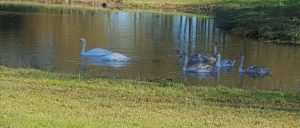
Even after the building work was done, and we were able to move in in 2003, there was still much to do, with house renovations continuing, including the erection of a proper garage with an additional personal work area above it where I’m currently writing this rubbish one wet afternoon, and also a surprising number of farm-related issues to sort out, which I won’t bore you with here. Some were good though, such as the chance in 2009 to purchase a further 23 acres that originally had been part of the farm, although that involved a lot of landscaping work in order to make it (very) nice. But amongst all this I did manage to get back into product design, although here too there were frustrations. You can read elsewhere about how I nearly came a cropper with the design of our Optospin filterwheel, which turned out to be a far more ambitious project than I had expected, but of which I am now (finally!!!) particularly proud. Also during this “farm era” we had a collaboration in which we were attempting to develop a confocal microscope based on a programmable display. Sadly that didn’t work out, but once the dust had settled we went ahead independently to develop our “Cairnfocal” microscope – a cheesy name we know, but at least it doesn’t have “Opto” in it. That’s looking very promising right now, with sales under way!
We had also been spending a fair while off and on developing a fourway image splitter to complement our two- and threeway ones, and which I gave a final “big push” to last year. One problem as a business grows is that inevitably people become more conservative, so there tends to be an increasing inertia against actually releasing anything until it is “completely ready” – whatever that means! (If only all of us could have been here in those earlier seat-of-pants days!) My own philosophy has been that as soon as something is in a functional state, someone somewhere will want to use it, so why not sell it to them? Either at a lower price, or with the promise of an upgrade to the full commercial version later. It brings in early cash, gives useful feedback for further development, and gives the customer the chance to be the first to use it experimentally, which is of great benefit in this current world where you are judged by how many papers you publish!
Closing thoughts
At such times, when I try to explain my own point of view on something like this to our steadily growing team, it can feel as if I’m back inside that pantomime horse again, except there is a slight difference this time round of course, in that I can now just canter off and do my own thing if need be. So I went ahead with cleaning up the “Multisplit” design, albeit in a very satisfactory way as I managed to include features that I originally thought wouldn’t fit, including full provision for accessory lenses for the simultaneous multidepth imaging application, (technical article and spreadsheet) and put in an order with our machining company for ten in order to get a good unit cost. Of course I’d have looked a bit of an idiot if it turned out that I’d ordered ten sets of scrap metal, but I’ve made an idiot of myself so often in life that one more time wouldn’t have made much difference. But all was well, we all seem very pleased with the result, and I’d made my point about being just a little more daring from time to time!
The Company has now grown to the extent that I won’t mention any more names, as I’m bound to forget someone, so please refer to our staff page for more information on that. The farm is proving to be a fantastic environment for everyone, and most of us seem to take advantage of being able to bring in a dog (or two!) to work with us, including me. I’ve been creating a dynasty of Hungarian Vizslas, and although patriarch Robi is no more, son Vinnie and grandson Bertie are both in cracking form, with Vinnie having taken over Robi’s task of spreading Vizsla genes around in a most satisfactory manner, and Bertie keen to have his turn in due course.
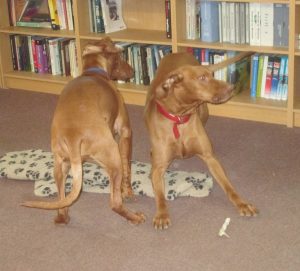
The other massive benefit of the farm purchase has been to give us the space to put up another building, which is now finally complete and in full operation and again paid for from retained profits. In fact the value of the farm as a whole has rocketed since we bought it, which in some ways is almost annoying. It represents money that we don’t owe, rather than cash in the bank, but we are in no way tempted to go for any “equity release”. An old fable about geese and golden eggs springs to mind here, and we want to ensure that this particular bird keeps laying! And who knows, we may need to put up yet another building one day. Hmmm, where would that one go….
This pretty much brings us up to the present day. It’s been, and continuing to be, a pretty amazing adventure, but with an interesting twist on the old “Plus ca change” saying. For Cairn to “stay the same” as we have grown, I have had to change a lot! The time when I was doing everything myself has long gone, and it’s been an interesting process to delegate away all the various aspects of running a business. Don’t get me wrong, I’m still very much involved, but I decided some while back that the best contribution I could make to the continuing growth of the business was to stay at the farm with the dogs and develop products like the Optospin, our image splitters and the Cairnfocal – although the latter is definitely a team effort nowadays, And I also regularly teach at the Plymouth and Paris workshops, plus attending the odd conference or two, so I’m not exactly reclusive.
So what about the future? In the short term we have the uncertainties of Brexit of course, and I’m repeatedly amazed that the idiotic reality has been far upstaging the satirical spoofs that have appeared on our website from time to time, and for which I have of course been responsible. We do have contingency plans, but prediction is a mug’s game – especially if it’s about the future – so we’ll just see what happens there and we’ll react accordingly. It’s for the longer term where can still have some element of control, so here are our thoughts on that.
We are working in a very competitive area, with new Companies starting up all the time. However, they seem mainly to be funded by venture capital, which is referred to by us at Cairn as “vulture capital”, as these guys will strip you to the bone in order to make money for themselves. The nature of that finance means that I cannot see how any of them will stay independent in the long term, in which case I guess the successful ones will sooner or later just get bought up by one of the conglomerates. That, of course, may be exactly what they want, but it’s not the future that we have in mind! So, while we must keep on our toes and continue to do cool stuff, I don’t see these Companies being a greater longterm threat to us than the conglomerates are now.
It also seems to us that a lot more money is being poured in than the market can ultimately support, so while we wish everyone well, in practice I do wonder how long some of them will last. I’d worry more if there were more Companies like us! While we are certainly not complacent, we do have a wide and strong product range, a well-established customer base, our own premises, no loans or outside investors, and of course the best people in this business. Cairn is here to do things for people, not to be flogged off. And we intend to keep it that way, so here’s to the next 30 years!

